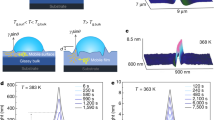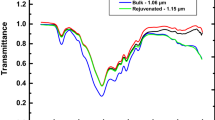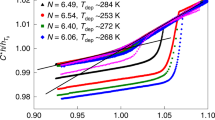Abstract
Long-chain, and network polymers are elastic over a range of temperature, known as the rubbery or plateau region1. On cooling they become rigid, or glassy, with a shear modulus of ∼10 GPa and, on heating, if crystallization or decomposition does not intervene non-network polymers become fluid with a shear modulus approaching zero. In the rubbery zone, the real component of their shear modulus, G', remains nearly constant and the mechanical loss factor, tan ψ, reaches a minimum value1. The occurrence of the rubbery state is exclusively a property of polymers in which topological constraints, resulting from chain entanglements, or junction points forming the network, exist2. These obviously involve flexible covalent bonds at junction points and intermolecuiar or interchain forces at entanglements. Here, we report the first observation of rubber-like behaviour in an ionic fluorozirconate glass3, currently of great interest for use as optical waveguides and infrared windows, and examine its implications for concepts of polymer rheology. These results are significant for they suggest that ionic bonds in non-polymers can provide the same configurational restrictions as covalent bonds in a macromolecule or a polymer.
This is a preview of subscription content, access via your institution
Access options
Subscribe to this journal
Receive 51 print issues and online access
$199.00 per year
only $3.90 per issue
Buy this article
- Purchase on Springer Link
- Instant access to full article PDF
Prices may be subject to local taxes which are calculated during checkout
Similar content being viewed by others
References
Ferry, J. D. Viscoelastic Properties of Polymers 3rd edn, (Wiley, New York, 1980).
Treloar, L. R. G. The Physics of Rubber-like Elasticity, 3rd edn (Clarendon, Oxford, 1975).
Poulain, M. Nature 293, 279–280 (1981).
Cavaille, J. Y. & Etienne, S. Mém. scient. Revue Métall. 383–418 (1984).
Etienne, S., Cavaille, J. Y., Perez, J., Point, R. & Salvia, M. Rev. scient. Intrum. 53, 1261–1264 (1982).
McCrum, N. G., Read, B. & Williams, G. Anelastic and Dielectric Effects in Polymeric Solids (Academic, New York, 1967).
Almeida, R. M. & MacKenzie, J. D. J. chem. Phys. 74, 5954–5961 (1981); J. Non-Cryst Solids 51, 187–199 (1982).
Lucas, J., Angell, C. A. & Tamaddon, S. Bull mater. Res. 19, 945–951 (1981).
Coupé, R. R., Louëer, D., Lucas, J. & Leonard, A. J. J. Am. Ceram. Soc. 66, 523–529 (1983).
Kawamoto, Y. & Horisaka, T. J. Non-Cryst. Solids 56, 39–44 (1983).
deGennes, P. G. J. chem. Phys. 55, 572–579 (1971); Physics Today 36, 33–39 (1983).
Doi, M. & Edwards, S. F. JCS Faraday Trans. II 74, 1789–1801, 1802–1817, 1818–1832 (1978); 75, 38–54 (1979).
Graessley, W. W. Adv. Polym. Sci. 47, 67–117 (1982).
Author information
Authors and Affiliations
Rights and permissions
About this article
Cite this article
Abbes, K., Mai, C., Etienne, S. et al. Rubber state of ionic fluorozirconate glasse. Nature 326, 479–480 (1987). https://doi.org/10.1038/326479a0
Received:
Accepted:
Published:
Issue Date:
DOI: https://doi.org/10.1038/326479a0
Comments
By submitting a comment you agree to abide by our Terms and Community Guidelines. If you find something abusive or that does not comply with our terms or guidelines please flag it as inappropriate.



